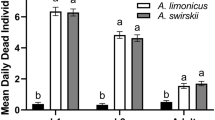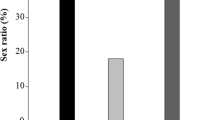Abstract
The purpose of this study was to determine the effects of the timing and rate of release on the population growth of Phytoseiulus persimilis (Acari: Phytoseiidae) reared on bean plants infested with two-spotted spider mite (TSM), Tetranychus urticae (Acari: Tetranychidae). Dwarf bean plants were infested with TSM and 20 P. persimilis females were introduced on each plant 3, 6, 9 and 12 days following TSM infestation. In another experiment, female P. persimilis were introduced at the rates of 5, 10 and 20 per plant 6 days after TSM infestation. The maximum per capita net population growth (MCPG) of P. persimilis was estimated as the maximum number of mobile stages observed on a plant during the course of the experiment divided by the initial number of females released on that plant. Both the timing and rate of release had a significant effect on the MCPG of P. persimilis. Releasing 20 P. persimilis on day nine resulted in an MCPG of 2.97, whereas releases on day 3, 6 or 12 resulted in MCPG values of less than 1.7. In the rate of release experiment, the highest MCPG (4.4) occurred when five female P. persimilis were released per plant, whereas releasing 10 and 20 predatory mites per plant led to MCPG values of 2.71 and 1.66, respectively. The findings indicate that the productivity of a P. persimilis rearing system may be significantly improved through optimization of the timing and/or rate of release.

Similar content being viewed by others
References
APRD. (2007). Arthropod pesticide resistance database. http://www.pesticideresistance.org/. Accessed May 27, 2007.
Badii, M. H., & McMurtry, J. A. (1984). Life history of and life table parameters for Phytoseiulus longipes with comparative studies on P. persimilis and Typhlodromus occidentalis (Acari: Phytoseiidae). Acarologia, 25, 111–123.
Begon, M., Harper, J. L., & Townsend, C. R. (1996). Ecology. Oxford, UK: Blackwell Science, Ltd.
Bolland, H. R., Gutierrez, J., & Flechtmann, C. H. W. (1998). World catalogue of the spider mite family (Acari: Tetranychidae). Leiden, the Netherlands: Koninklijke Brill NV.
Campbell, C. A. M., & Lilley, R. (1999). The effects of timing and rates of release of Phytoseiulus persimilis against two-spotted spider mite Tetranychus urticae on dwarf hops. Biocontrol Science and Technology, 9, 453–465.
Carey, J. R. (1993). Applied demography for biologists. New York, NY: Oxford University Press, Inc.
Caswell, H. (2001). Matrix population models: Construction, analysis, and interpretation. Sunderland, MA, USA: Sinauer Associates, Inc.
Copping, L. G. (2004). The manual of biocontrol agents. Alton, UK: BCPC.
Croft, B. A., & van de Baan, H. E. (1988). Ecological and genetic factors influencing evolution of pesticide resistance in tetranychid and phytoseiid mites. Experimental & Applied Acarology, 4, 277–300.
Decou, G. C. (1994). Biological control of the two-spotted spider mite (Acarina: Tetranychidae) on commercial strawberries in Florida with Phytoseiulus persimilis (Acarina: Phytoseiidae). The Florida Entomologist, 77, 33–41.
EPPO. (2002). List of biological control agents widely used in the EPPO region. EPPO Bulletin, 32, 447–461.
Escudero, L. A., & Ferragut, F. (2005). Life-history of predatory mites Neoseiulus californicus and Phytoseiulus persimilis (Acari: Phytoseiidae) on four spider mite species as prey, with special reference to Tetranychus evansi (Acari: Tetranychidae). Biological Control, 32, 378–384.
Fournier, D., Millot, P., & Pralavorio, M. (1985). Rearing and mass production of the predatory mite Phytoseiulus persimilis. Entomologia Experimentalis et Applicata, 38, 97–100.
Garthwaite, D. (2000). Changes in biological control usage in Great Britain between 1968 and 1995 with particular reference to biological control on tomato crops. Biocontrol Science and Technology, 10, 451–457.
IOBC. (2010). Database on selectivity of pesticides to beneficial organisms. http://www.iobc-wprs.org/ip_ipm/03022_IOBC_PesticideDatabase_2005.pdf. Accessed June 10, 2010.
Irigaray, F. J., Zalom, F. G., & Thompson, P. B. (2007). Residual toxicity of acaricides to Galendromus occidentalis and Phytoseiulus persimilis reproductive potential. Biological Control, 40, 153–159.
Janssen, A., & Sabelis, M. W. (1992). Phytoseiid life-histories, local predator-prey dynamics, and strategies for control of tetranychid mites. Experimental & Applied Acarology, 14, 233–250.
Koveos, D. S., & Broufas, G. D. (2000). Functional response of Euseius finlandicus and Amblyseius andersoni to Panonychus ulmi on apple and peach leaves in the laboratory. Experimental & Applied Acarology, 24, 247–256.
Markou, M., & Papadavid, G. (2007). Norm input output data for the main crop and livestock enterprises of Cyprus. Agricultural Economics Report (Cyprus) 46. ISSN 0379-0827.
McMurtry, J. A., & Croft, B. A. (1997). Life-styles of phytoseiid mites and their role in biological control. Annual Review of Entomology, 42, 291–321.
Nicetic, O., Watson, D. M., Beattie, G. A., Meats, C. A., & Zheng, J. (2001). Integrated pest management of two-spotted mite Tetranychus urticae on greenhouse roses using petroleum spray oil and the predatory mite Phytoseiulus persimilis. Experimental & Applied Acarology, 25, 37–53.
Opit, G. P., Nechols, J. R., & Margolies, D. C. (2004). Biological control of two-spotted spider mites, Tetranychus urticae Koch (Acari: Tetranychidae), using Phytoseiulus persimilis Athias-Henriot (Acari: Phytoseiidae) on ivy geranium: Assessment of predator release ratios. Biological Control, 29, 445–452.
Overmeer, W. P. J. (1985a). Alternative prey and other food sources. In W. Helle & M. W. Sabelis (Eds.), Spider mites - their biology, natural enemies and control Volume 1B (pp. 131–139). Amsterdam, the Netherlands: Elsevier Science.
Overmeer, W. P. J. (1985b). Rearing and handling. In M. W. Sabelis (Ed.), Spider mites - their biology, natural enemies and control Volume 1B (pp. 161–170). Amsterdam, the Netherlands: Elsevier Science.
Popov, N. A., & Khudyakova, O. A. (1989). Development of Phytoseiulus persimilis (Acarina, Phytoseiidae) fed on Tetranychus urticae (Acarina, Tetranychidae) on various food plants. Acta Entomologica Fennica, 53, 43–46.
R Core Development Team. (2007). R: A language and environment for statistical computing. R Foundation for Statistical Computing, Vienna, Austria. http://www.R-project.org.
Sabelis, M. W. (1991). Life-history evolution of spider mites. In R. Schuster & P. W. Murphy (Eds.), The Acari: reproduction, development and life-history strategies (pp. 23–50). London, UK: Chapman & Hall.
Sabelis, M. W., & Janssen, A. (1993). Evolution of life-history patterns in the Phytoseiidae. In M. A. Houck (Ed.), Mites: ecological and evolutionary analyses of life-history patterns (pp. 70–98). New York, NY: Chapman & Hall.
Sabelis, M. W., van Baalen, M., Pels, B., Egas, M., & Janssen, A. (2002). Evolution of exploitation and defense in plant–herbivore–predator interactions. In U. Dieckmann, J. A. J. Metz, M. W. Sabelis, & K. Sigmund (Eds.), The adaptive dynamics of infectious diseases: in pursuit of virulence management (pp. 297–321). Cambridge, UK: Cambridge University Press.
Sanderson, J. P., & Zhang, Z. Q. (1995). Dispersion, sampling, and potential for integrated control of two-spotted spider mite (Acari: Tetranychidae) on greenhouse roses. Journal of Economic Entomology, 88, 343–351.
Stavrinides, M. C., & Hadjistylli, M. (2009). Two-spotted spider mite in Cyprus: ineffective acaricides, causes and considerations. Journal of Pest Science, 82, 123–128.
Tanigoshi, L. K., Martin, N. A., Osborne, L. S., & Peña, J. E. (2004). Biological control of spider mites on ornamental crops. In K. M. Heinz, R. G. Van Driesche, & M. P. Parrella (Eds.), Biocontrol in protected culture (pp. 185–199). Batavia, IL, USA: Ball Publishing.
Zar, J. H. (1999). Biostatistical analysis. Upper Saddle River, NJ, USA: Prentice-Hall, Inc.
Acknowledgments
Appreciation is expressed to Hadjigiannis Costas and Constantinou Fytos for helping with observations and Seraphides Nikos and Georghiou Andreas for providing space and technical support at the ARI Insectary. Thanks are extended to Nicholas J. Mills of the University of California at Berkeley (USA) for his assistance with the matrix population model. Maurice W. Sabelis and an anonymous reviewer provided constructive comments that significantly improved this manuscript.
Author information
Authors and Affiliations
Corresponding author
Rights and permissions
About this article
Cite this article
Stavrinides, M.C. The effects of timing and rate of release on population growth of Phytoseiulus persimilis reared on Tetranychus urticae . Phytoparasitica 38, 349–354 (2010). https://doi.org/10.1007/s12600-010-0111-y
Received:
Accepted:
Published:
Issue Date:
DOI: https://doi.org/10.1007/s12600-010-0111-y




